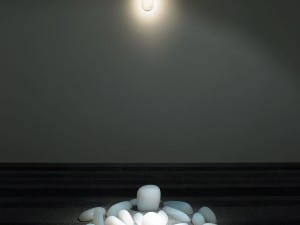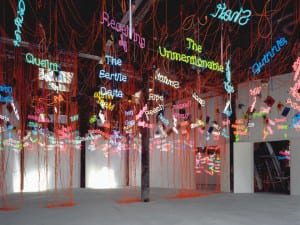Beijing’s Liu Wei grew up as part of generation of artists who experienced rapid urbanisation. But there’s no indication of the Chinese cityscape in this White Cube exhibition, Density. Throughout the show – which is presented over two floors – the audience is taken away from China into an unknown space where the voluminous masses that fill the gallery space are static and lifeless.
Wei’s methods of using found objects is particularly interesting when it comes to considering the environment he has been working in. With a wealth of available material, he produces large scale structures from what he has found: wood, metal, piping, old doors and large sheets of canvas. Through this direct link to the landscape around him, Wei’s pieces are inextricably part of the landscape from which they came. It is therefore fair to deduce comment from this association: there’s meaning to be found in the juxtaposition of the object in terms of its physical mass, with the serenity of the atmosphere surrounding it.
The construction of the pieces in Jungle No.21 (2013) shows material that has been stretched taught over the canvas surface, gathered at the sides and forcibly bolted to the corners with a steel screw. There’s almost pain to be found in the stillness of the works – a tangible desire to be released from the pressure building up on the canvas.
Finding meaning in the physical mass of the geometric sculptures, the historical eye brings to life the most famous of visual keys: Cairo’s pyramids. When considering Ancient Egypt and the society that built those structures, the monuments are representative of order. This isn’t the case for Wei’s artworks. The geometric formulas he employs allow for minimalist simplicity of line and form. There’s even spiritual element to be deducted from the calmness of the sculptural presentation of Density 1 (2013) for example. But they’re more oppressive than calm – again, alluding to the artist’s experience of his urban environment. Wei therefore comments on the process of what he sees: the chaotic realness of urban development is shown in the materials he uses, which is presented in this gallery space as a passive threat to serenity.
“Density” as a title for the exhibition not only conjures familiar photographic memories of what we see Chinese cities to be – but in the gallery, the density of the artworks is also suggestive of a metaphorical state of pressure and impenetrability. As the pieces are impenetrable in their physical state (and sometimes in their meaning) it forces the viewer to create an understanding of the pieces in the context within which they view it – the gallery space. The exhibition becomes interesting here as it asks the visitor to work hard at finding meaning, leaving whatever “truth” to be found as an open concept. This serene openness of the atmosphere that engulfs the artworks, evidently comes in part, from the “white cube effect”…and what an apt gallery to display these works.
Liu Wei: Density, until 15 March, White Cube, 25 – 26 Mason’s Yard, London, SW1Y 6BU.
Asana Greenstreet
Credits
1. Liu Wei White Cube Masons Yard London 29 January – 15 March 2014.





